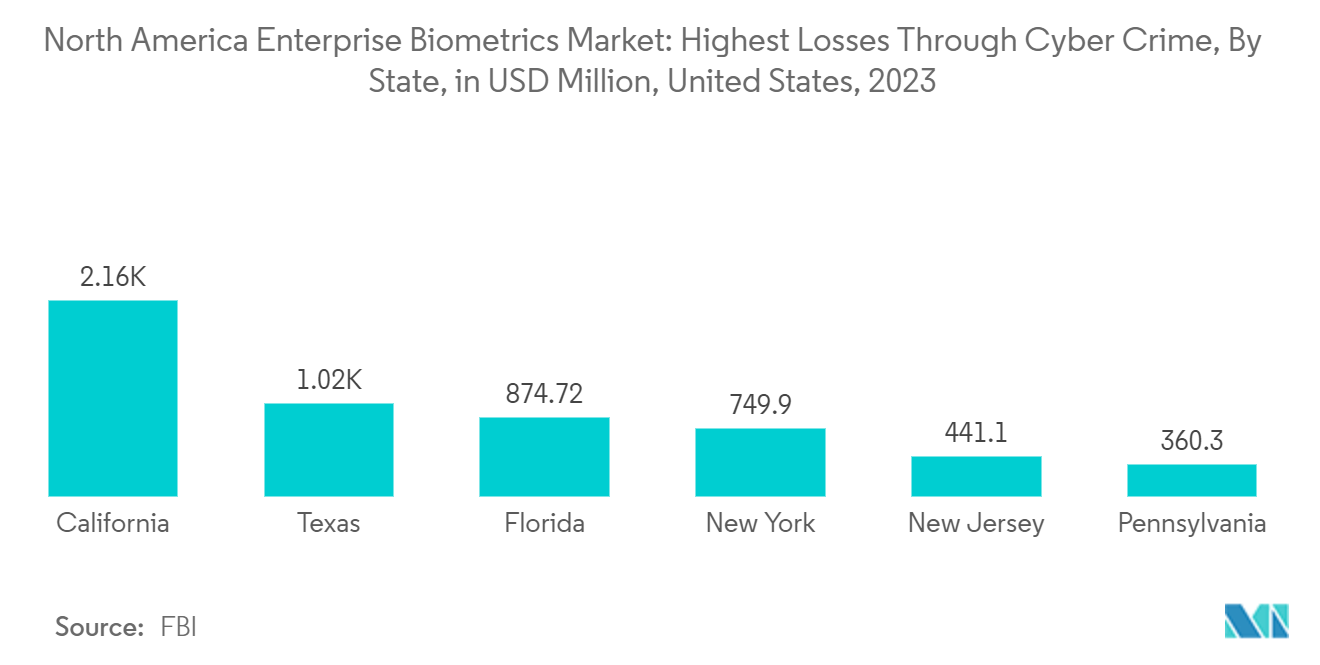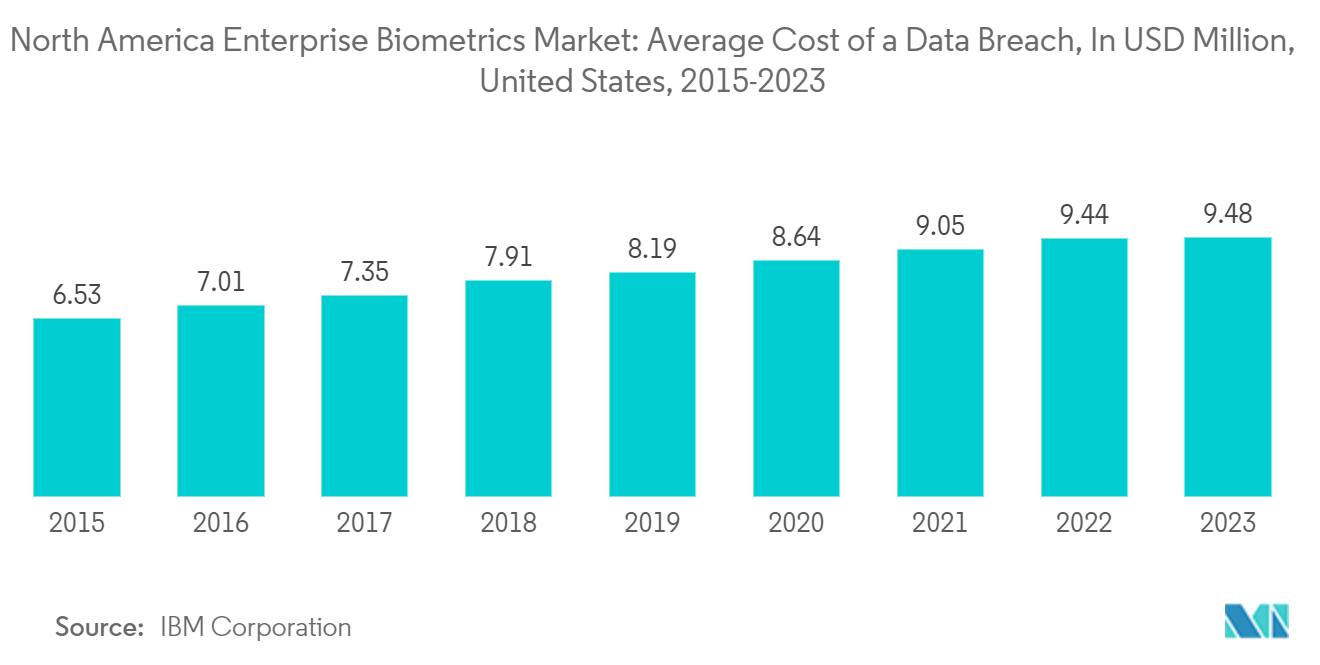Market Trends of North America Enterprise Biometrics Industry
Increasing Privacy and Security Concerns are Anticipated to Drive the Demand for the Studied Market
- With the escalating cybercrime and identity theft threats, businesses are increasingly investing in robust security measures. Traditional authentication methods, like passwords and PINs, are susceptible to breaches. Enterprise biometrics provides a more secure alternative, as it depends on unique physical or behavioral characteristics that are difficult to replicate or forge.
- For instance, according to the Federal Bureau of Investigation (FBI), in 2023, California ranked first by the amount of monetary losses through cybercrime. The state had over USD 2 billion of reported losses. Texas was second in cybercrime losses, reporting around USD 1 billion, while Florida followed with USD 874 million. Furthermore, in 2023, the monetary damage caused by cybercrime reported to the United States' Internet Crime Complaint Center (IC3) witnessed a year-over-year increase of around 21%, amounting to a historical peak of USD 12.5 billion.
- Furthermore, many industries are subject to stringent data protection and security regulations. Enterprise biometrics can help organizations comply with these regulations by offering additional protection. Biometrics offers a higher assurance level than traditional authentication methods, ensuring that sensitive data is only accessible to authorized personnel.
- The United States has witnessed the implementation of stringent regulations, such as the Health Insurance Portability and Accountability Act (HIPAA) and the Payment Card Industry Data Security Standard (PCI DSS). These regulations require organizations to implement robust security measures to protect sensitive customer data. Enterprise biometrics offers a reliable solution for ensuring compliance with such regulations, driving its adoption across industries.
- Technological advancements have led to significant improvements in biometric systems, including accuracy, speed, and reliability. Machine learning algorithms and artificial intelligence (AI) have enhanced the capabilities of biometric solutions, reducing false acceptance and rejection rates. These advancements have instilled confidence in businesses to adopt and rely on biometric authentication.
- Additionally, blockchain technology offers a decentralized and tamper-proof storage solution for biometric data. Integrating biometrics with blockchain can enhance data security, privacy, and interoperability, ensuring that sensitive biometric information is securely stored and shared across different systems and organizations. This integration can facilitate seamless and secure authentication processes in enterprise settings.

The United States is Anticipated to Hold Major Market Share
- In the United States, technological advancements have paved the way for multimodal biometrics, which combine multiple biometric modalities for enhanced accuracy and security. Enterprises are increasingly adopting multimodal systems integrating facial, voice, fingerprint, and behavioral biometrics to provide a more comprehensive and robust authentication process. Artificial intelligence (AI) and machine learning (ML) have revolutionized the biometrics industry by enabling more accurate and efficient identification and authentication processes.
- According to IBM Corporation, as of 2023, the average data breach cost in the United States amounted to USD 9.48 million, up from USD 9.44 million in 2022. The global average cost per data breach was USD 4.45 million in 2023. Such instances are likely to aid the adoption of enterprise biometrics in the United States.
- Several market vendors in the United States are striving to launch new and comprehensive products to cater to consumers' evolving requirements. For instance, in November 2023, Amazon Web Services (AWS) introduced Amazon One Enterprise, a contactless security solution tailored for granting access to various locations, including offices, airports, hotels, and educational institutions.
- The traditional methods of authentication, as highlighted in the release, typically necessitate manual verification and credential management and incur costs for producing physical IDs. Furthermore, the inconvenience of misplacing or forgetting badges, PINs, or passwords can result in significant productivity losses. AWS asserts that Amazon One Enterprise effectively streamlines and reduces the operational burdens tied to conventional authentication management.
- The widespread adoption of smartphones and other mobile devices has paved the way for mobile biometrics. Features like fingerprint scanning and facial recognition have become commonplace in consumer devices, leading to increased acceptance and familiarity with biometric technology. As a result, enterprises are leveraging mobile biometrics to enhance security and improve user experience, further driving the market for enterprise biometrics in the United States.
- Also, increasing data security and privacy regulations, such as the General Data Protection Regulation (GDPR) and the California Consumer Privacy Act (CCPA), have compelled organizations to implement more robust security measures. With its ability to ensure secure access control and identity verification, enterprise biometrics helps organizations meet these regulatory requirements, driving the demand for biometric solutions in the United States.
- Moreover, as wearable technology gains popularity, integrating biometric sensors into smartwatches, fitness bands, and other wearable devices presents immense potential for the enterprise biometrics market. Biometric wearables can provide seamless and unobtrusive authentication, allowing employees to access systems and data with a simple gesture or touch.


